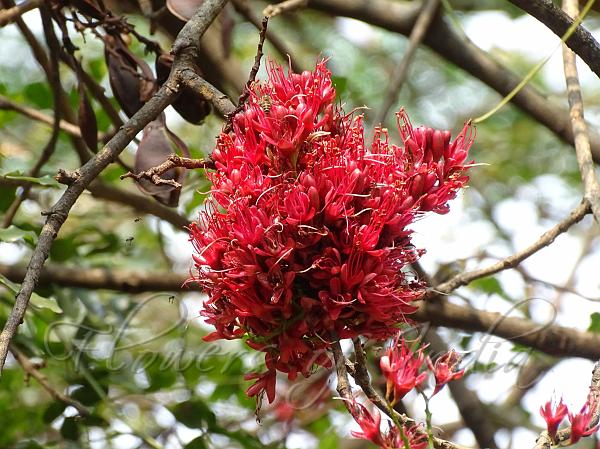|
| Weeping Boer-Bean |
|

|

| File size | 862382 |
| Original date | 3/8/17 10:41 AM |
| Resolution | 2048 x 1536 |
| Flash | Flash did not fire, auto |
| Focal length | 101.01mm |
| Exposure time | 1/200s |
| Aperture | 5.6 |
| Focus Distance | |
| Metering Mode | Spot |
| Camera make | SONY |
| Camera model | DSC-HX400V |
| Sensor type |
|
|
|
|
Photo: |
Botanical name: Schotia brachypetala Family: Fabaceae (Pea family)
Synonyms: Schotia semireducta Merxm.
Synonyms: Schotia semireducta Merxm.
Weeping Boer-Bean is a handsome, medium to large
tree with a wide-spreading, densely branched, rounded crown. It has a
single trunk that sometimes branches low down. Trees can becomes as
tall as 22 m, but most commonly grow 11-16 m with a spread of 10-15 m.
The bark is rough and brown or grey brown. The leaves are compound,
with 4-6 pairs of leaflets, each with an entire, wavy margin. The
foliage is reddish to coppery when young, turning bright green and
maturing to a glossy dark green. In warm frost-free areas this tree is
evergreen, but in colder regions it is deciduous, losing its leaves for
a short period in winter to spring. The flowers are rich deep red, and
are produced in masses, in dense branched heads on the old wood during
spring. The flowering time is quite irregular, thus ensuring a longer
feeding season for nectar loving birds. The fruit is a hard, flattened,
woody, dark brown pod containing flattened, pale brown approximately 2
cm in diameter, seeds with a prominent yellow aril. The pods split on
the tree, maturing during late summer to autumn. The woodland tree is
native to Africa south of the Zambezi River, where it occurs at middle
altitudes.
Medicinal uses: Liquid from the boiled bark
are used to treat heartburn and hangovers. Mixtures of the bark and
root are used to purify the blood, to treat nervous heart conditions
and diarrhoea, and to strengthen the body. The roasted seeds are
edible, low in fat and protein but high in carbohydrates. They were
widely used as a valuable food source and as a coffee substitute by the
early settlers. The bark produces a red-brown or red coloured dye.
Liquid from the boiled bark
are used to treat heartburn and hangovers. Mixtures of the bark and
root are used to purify the blood, to treat nervous heart conditions
and diarrhoea, and to strengthen the body. The roasted seeds are
edible, low in fat and protein but high in carbohydrates. They were
widely used as a valuable food source and as a coffee substitute by the
early settlers. The bark produces a red-brown or red coloured dye.
Medicinal uses:
 Liquid from the boiled bark
are used to treat heartburn and hangovers. Mixtures of the bark and
root are used to purify the blood, to treat nervous heart conditions
and diarrhoea, and to strengthen the body. The roasted seeds are
edible, low in fat and protein but high in carbohydrates. They were
widely used as a valuable food source and as a coffee substitute by the
early settlers. The bark produces a red-brown or red coloured dye.
Liquid from the boiled bark
are used to treat heartburn and hangovers. Mixtures of the bark and
root are used to purify the blood, to treat nervous heart conditions
and diarrhoea, and to strengthen the body. The roasted seeds are
edible, low in fat and protein but high in carbohydrates. They were
widely used as a valuable food source and as a coffee substitute by the
early settlers. The bark produces a red-brown or red coloured dye.
| Identification credit: Ajit Ampalakkad | Photographed in Bangalore. |
• Is this flower misidentified? If yes,